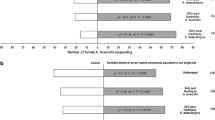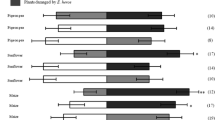Abstract
The weevil Oxyops vitiosa is an Australian species imported to Florida, USA, for the biological control of the invasive species Melaleuca quinquenervia. The larvae of this species feed on the leaves of their host and produce a shiny orange secretion that covers their integument. Previous results indicated that a major component of this secretion, viridiflorol, is sequestered from the host plant and repels a generalist predator, the red imported fire ant, Solenopsis invicta. When the larvae fed on a different chemotype of M. quinquenervia, which lacked viridiflorol but was rich in a different sesquiterpene, (E)-nerolidol, similar protection occurred. Solvent washes of these larvae indicated that (E)-nerolidol was sequestered from M. quinquenervia leaves and repelled S. invicta workers when applied to dog food baits at physiological concentrations (17.5, 35.0, and 52.5 μg/mg). Additionally, β-caryophyllene also repelled S. invicta workers when applied to dog food baits at concentrations that approximated those in the O. vitiosa larval secretions (3.5 and 35 μg/mg). When the O. vitiosa larvae were fed leaves from laboratory hosts (nonfield hosts), similar repellent activity was found. This activity was traced to several of the same compounds (e.g., 1,8-cineole, viridiflorol) found to be active in their field host M. quinquenervia. These weevil larvae are opportunistic, sequestering the primary terpenoids in their host leaves that confer antipredator activity.
Similar content being viewed by others
References
Aplin, R. T., Benn, M. H., and Rothschild, M. 1968. Poisonous alkaloids in the body tissues of the Cinnabar Moth (Callimorpha jacobaeae L.). Nature 219:747-748.
Balciunas, J. K. and Buckingham, G. R. 1996. Release of the Australian weevil Oxyops vitiosa for control of Melaleuca quinquenervia. pp. 23Unpublished Report Submitted to TAG for Release of Biological Control Agent.
Balciunas, J. K., Burrows, D. W., and Purcell, M. F. 1994. Field and laboratory host ranges of the Australian weevil, Oxyops vitiosa (Coleoptera: Curculionidae), a potential biological control agent for the paperbark tree, Melaleuca quinquenervia. Biol. Control 4:351-360.
Bowers, M. D. 1990. Recycling plant natural products for insect defense, pp. 353-386, in D. L. Evans and J. O. Schmidt (Eds.). Insect Defenses: Adaptive Mechanisms and Strategies of Prey and Predators. State University of New York Press, Albany, New York.
Brophy, J. J. and Doran, J. C. 1996. Essential Oils of Tropical Asteromyrtus, Callistemon and Melaleuca Species. ACIAR Monograph Series No. 40, Canberra, Australia.
Brophy, J. J., Lassak, E. V., and Toia, R. F. 1985. The volatile leaf oils of two cultivars of Callistemon viminalis. J. Proc. R. Soc. NSW 118:101-104.
Brophy, J. J., Boland, D. J., and Lassak, E. V. 1989. Leaf essential oils of Melaleuca and Leptospermum species from tropical Australia, pp. 193-203, in D. J. Boland (ed.). Trees for the Tropics: Growing Australian Multipurpose Trees and Shrubs in Developing Countries. Australian Centre for International Agricultural Research, Canberra, Australia.
Brophy, J. J., Forster, P. I., and Punruckvong, A. 1997. Variation in Callistemon viminalis (Myrtaceae): new evidence from leaf essential oils. Aust. Syst. Bot. 10:1-13.
Byrnes, N. B. 1986. A revision of Melaleuca L. (Myrtaceae) in northern and eastern Australia 3. Austrobaileya 2:254-273.
Center, T. D., Van, T. K., Rayachhetry, M., Buckingham, G. R., Dray, F. A., Wineriter, S., Purcell, M. F., and Pratt, P. D. 2000. Field colonization of the Melaleuca snout beetle (Oxyops vitiosa) in south Florida. Biol. Control 19:112-123.
Ciomperlik, M. A., Chandler, J. M., and DeLoach, C. J. 1992. Predation by red imported fire ant on Tyta luctuosa released for control of field bindweed. Southwest Entomol. 17:267-269.
Conover, W. J. 1999. Practical Nonparametric Statistics, 3rd ed. John Wiley & Sons, New York.
Cornelius, M. L., and Bernays, E. A. 1995. The effect of plant chemistry on the acceptability of caterpillar prey to the Argentine ant Iridomyrmex humilils (Hymenoptera: Formicidae). J. Insect Behav. 8:579-593.
Craven, L. A. 1999. Behind the names: the botany of tea tree, Cajuput and Niaouli, pp. 11-28, in I. A. Southwell and R. Lowe (Eds.). Tea Tree: The Genus Melaleuca. Harwood Academic Publishers, New York.
Crawley, M. J. 1989. The successes and failures of weed biocontrol using insects. Biocontrol News Inform. 19:213-223.
Cronquist, A. 1981. An Integrated System of Classification of Flowering Plants. Columbia University Press, New York.
Debbrecht, F. J. 1985. Qualitative and quantitative analysis by gas chromatography, pp. 359-421, in R. L. Grob (ed.). Modern Practices of Gas Chromatography. Wiley, New York.
Degen, T. and Stadler, E. 1998. Oviposition of carrot fly (Psila rosae) in response to foliage and leaf surface extracts of the host plants. Chemoecology 8:39-49.
Elvin, M. K., Stimac, J. L., and Whitcomb, W. H. 1983. Estimating rates of arthropod predation on velvetbean caterpillar larvae in soybeans. Fl. Entomol. 66:319-330.
Espelie, K. E. and Bernays, E. A. 1989. Diet-related differences in the cuticular lipids of Manduca sexta larvae. J. Chem. Ecol. 15:2003-2017.
Gershenzon, J. and Croteau, R. 1991. Terpenoids, pp. 165-219, in G. A. Rosenthal and M. Berenbaum (Eds.). Herbivores: Their Interactions with Secondary Plant Metabolites. Vol I: The Chemical Participants, 2nd ed. Academic Press, San Diego, California.
Gibbs, R. D. 1974. Chemotaxonomy of Flowering Plants, McGill-Queens University Press, Montreal, Canada.
Goeden, R. D. and Louda, S. M. 1976. Biotic interference with insects imported for weed control. Annu. Rev. Entomol. 21:325-342.
Gomez, N. E., Witte, L., and Hartmann, T. 1999. Chemical defense in larval tortoise beetles: Essential oil composition of fecal shields of Eurypedus nigrosignata and foliage of its host plant, Cordia curassavica. J. Chem. Ecol. 25:1007-1027.
Ireland, B. F., Hibbert, D. B., Goldsack, Doran, J. C., and Brophy, J. J. 2002. Chemical variation in the leaf essential oil of Melaleuca quinquenervia (Cav.) S. T. Blake. Biochem. Syst. Ecol. 30:457-470.
Jeffries, M. J. and Lawton, J. H. 1984. Enemy free space and the structure of ecological communities. Biol. J. Linn. Soc. 23:269-289.
Jones, C. G., Whitman, D. W., Silk, P. J., and Blum, M. S. 1988. Diet breadth and insect chemical defenses: a generalist grasshopper and general hypotheses, pp. 477-512, in K. C. Spencer (ed.). Chemical Mediation of Coevolution. Academic Press, New York.
Julien, M. H. and Griffiths, M. W. 1998. Biological Control of Weeds, a World Catalogue of Agents and their Target Weeds, 4th ed. CAB International, Oxon, United Kingdom.
Kharboutli, M. W. and Mack, T. P. 1991. Relative and seasonal abundance of predaceous arthropods in Alabama peanut fields as indexed by pitfall traps. J. Econ. Entomol. 84:1015-1023.
Lofgren, C. S., Banks, W. A., and Glancey, B. M. 1975. Biology and control of imported fire ants. Annu. Rev. Entomol. 20:1-30.
Loughrin, J. H., Manukian, A., Heath, R. R., and Tumlinson, J. H. 1995. Volatiles emitted by different cotton varieties damaged by feeding beet armyworm larvae. J. Chem. Ecol. 21:1217-1227.
Montgomery, B. R. and Wheeler, G. S. 2000. Anti-predatory activity of the weevil Oxyops vitiosa: a biological control agent of Melaleuca quinquenervia. J. Insect Behav. 13:915-926.
Purcell, M. F. and Balciunas, J. K. 1994. Life history and distribution of the Australian weevil Oxyops vitiosa (Coleoptera: Curculionidae), a potential biological control agent for Melaleuca quinquenervia (Myrtaceae). Ann. Entomol. Soc. Am. 87:867-873.
Ramanoelina, P. A. R., Viano, J., Bianchini, J. P., and Gaydou, E. M. 1994. Occurrence of various chemotypes in niaouli (Melaleuca quinquenervia) essential oils from Madagascar using multivariate statistical analysis. J. Agric. Food Chem. 42:1177-1182.
Rees, C. J. C. 1969. Chemoreceptor specificity associated with choice of feeding site by the beetle Chrysolina brunsvicensis on its foodplant Hypericum hirsutum. Entomal. Exp. Appl. 12:565-583.
Rowell-Rahier, M. and Pasteels, J. M. 1992. Third trophic level influences of plant allelochemicals, pp. 243-277, in G. A. Rosenthal and M. R. Berenbaum (Eds.). Herbivores: Their Interactions with Secondary Plant Metabolites. Vol II. Ecological and Evolutionary Processes. 2nd ed. Academic Press, San Diego, California.
SAS Institute. 1990. SAS/STAT User's Guide, Version 6. SAS Institute. Cary, North Carolina.
Seigler, D. S. 1981. Secondary metabolites and plant systematics, pp. 139-176, in E. E. Conn (ed.). Secondary Plant Products, Vol. 7. Academic Press, New York.
Slansky, F., Jr. and Scriber, J. M. 1985. Food consumption and utilization, pp. 87-163, in G. A. Kerkut and L. I. Gilbert (Eds.). Comprehensive Insect Physiology, Biochemistry and Pharmacology, Vol. 4. Pergamon, Oxford.
Southwell, I. A. and Lowe, R. (Eds.) 1999. Tea Tree: The Genus Melaleuca. Harwood Academic Publishers, New York.
Southwell, I. A., Maddox, C. D. A., and Zalucki, M. P. 1995. Metabolism of 1,8-cineole in tea tree (Melaleuca alternifolia and M. linariifolia) by pyrgo beetle (Paropsisterna tigrina). J. Chem. Ecol. 21:439-453.
Turlings, T. C. J., Tumlinson, J. H., and Lewis, W. J. 1990. Exploitation of herbivore-induced plant odors by host-seeking parasitic wasps. Science 250:1251-1253.
Wheeler, G. S., Massey, L. M., and Southwell, I. A. 2002. Anti-predator defense of the biological control agent Oxyops vitiosa is mediated by plant volatiles sequestered from their host plant Melaleuca quinquenervia. J. Chem. Ecol. 28:281-299.
Wink, M., Hartmann, T., Witte, L., and Rheinheimer, J. 1982. Interrelationship between quinolizidine alkaloid producing legumes and infesting insects: exploitation of the alkaloid-containing phloem sap of Cytisus scoparius by the broom aphid Aphis cytisorum. Z. Naturforsch. 37c:1081-1086.
Young, D. A. and Seigler, D. S. 1981. Phytochemistry and Angiosperm Phylogeny. Praeger, New York.
Author information
Authors and Affiliations
Corresponding author
Rights and permissions
About this article
Cite this article
Wheeler, G.S., Massey, L.M. & Southwell, I.A. Dietary Influences on Terpenoids Sequestered by the Biological Control Agent Oxyops vitiosa: Effect of Plant Volatiles from Different Melaleuca quinquenervia Chemotypes and Laboratory Host Species. J Chem Ecol 29, 189–208 (2003). https://doi.org/10.1023/A:1021941000399
Issue Date:
DOI: https://doi.org/10.1023/A:1021941000399




